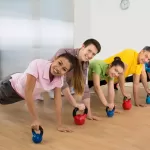How to Get Started With a Fitness Routine in 5 Easy Steps
Getting started with a fitness routine may seem intimidating at first, but it doesn’t have to be. With some planning, smart goal-setting, and by making exercise an enjoyable habit, you can successfully get on track to better health and fitness.
Follow these 5 essential steps to kickstart your workout regimen and start seeing awesome results!
Step 1: Define Your Fitness Goals
Table of Contents
ToggleBefore lacing up your sneakers and hitting the gym, take some time to clearly define what you want to accomplish through exercise. Setting clear fitness goals will help you stay focused, motivated and on track when the workouts get tough.
Here are some of the main benefits you can experience through regular physical activity:
- Improved cardiovascular health and lowered heart disease risk
- Reduced blood pressure and cholesterol levels
- Increased muscle mass and strength
- Weight loss and improved body composition
- Reduced risk of obesity, diabetes and certain cancers
- Increased bone density, reducing osteoporosis risk
- Better joint mobility and flexibility
- Improved balance and coordination
- Enhanced cognitive function and reduced dementia risk
- Better sleep quality
- Improved mood, reduced stress and anxiety
- Increased energy levels and stamina
With all these rewards, it’s no wonder exercise is considered one of the best things you can do for your overall health!
Now let’s look at how to set S.M.A.R.T. fitness goals that will help you experience these incredible benefits.
Make Goals Specific and Measurable
Having concrete metrics to strive for makes goals more powerful and motivation easier to maintain. Some examples of specific, quantified fitness goals could include:
- Lose 25 lbs to reach a goal weight of 135 lbs
- Lower resting heart rate from 80 bpm to 70 bpm
- Run 2 miles nonstop at an 10 min/mile pace
- Increase pushups from 10 to 50 consecutive reps
- Squat bodyweight for 15 reps with proper form
- Complete a 30-minute HIIT workout routine with good intensity
Set Achievable, Relevant Goals
Make sure your fitness goals are well-matched to your starting fitness level. Avoid setting unrealistic targets that are bound to fail. Goals should challenge yet motivate you. Other tips:
- Tailor weight loss goals to your starting weight – 1-2 lbs per week is a safe, sustainable rate
- Determine target heart rate zones using your age and current fitness
- Set strength goals based on your ability to currently lift a certain weight for a certain number of reps
- Build up cardio endurance gradually – add 5-10 minutes each week
Give Yourself a Timeline
Providing a target date creates a sense of urgency and helps you commit. Example fitness goal timeframes:
- Lose 20 lbs in 5 months
- Complete a marathon in 1 year
- Increase deadlift by 50 lbs in 3 months
- Hold a plank for 2 minutes in 6 weeks
Be realistic with your timelines. Consistency and dedication over months and years creates major transformation.
Track Your Progress
Monitoring your fitness journey helps you stay on course to hit your goals. Useful tracking metrics:
- Weight on the scale
- Body measurements with tape measure
- Before/after photos of physique
- Fitness app data like steps, calories burned, heart rate
- Numbers from workout journal like weight lifted, reps completed
Celebrate small wins and milestones. Tracking progress provides accountability and visual proof of your hard work.
By setting S.M.A.R.T. fitness goals tailored to your current ability and health profile, you equip yourself to succeed right from the starting line. Review and update your goals every few months to continue challenging yourself.
Step 2: Schedule Your Workouts and Create a Plan
Now that you know what you want to accomplish through exercise, it’s time to schedule workouts and plot out an actual fitness plan.
In the beginning, it’s easy to have good intentions about exercising that fizzle out after a few weeks. The key to making fitness stick is planning and dedication. Treat workouts like important appointments that cannot be missed or rescheduled.
Block Off Workout Days and Times
Pull out your calendar and schedule 3-5 exercise sessions each week. Having designated days and times carved out in advance will greatly increase your chances of sticking to a routine.
Aim to have a mixture of resistance/strength training and cardio workouts. For optimal results, experts recommend each muscle group be trained 2-3 times per week. Plan rest days in between weight lifting sessions.
If possible, schedule workouts early in the day. Morning exercise releases endorphins, reducing daily stress while energizing you. It’s also harder to make excuses to skip planned evening workouts if you’re tired after work.
Can’t imagine waking up to exercise? Start by working out in the afternoon or evening, then gradually move your sessions earlier over time. This tactic eases you into an AM workout habit.
Structure Your Workouts
Now fill in what types of exercise you’ll do on the days you’ve scheduled. Follow this template for well-rounded weekly workouts:
- 2 days of resistance training: Target upper body, lower body and core each workout.
- 2 days of cardio: Mix steady state (e.g. running) with interval training (e.g. sprints).
- Optional 5th day for yoga, Pilates or light activity.
- 2 rest days for muscle recovery.
Your workout schedule may look something like:
- Monday: Upper body weights + abs
- Tuesday: HIIT sprints
- Wednesday: Lower body weights + abs
- Thursday: Steady state cardio
- Friday: Rest
- Saturday: Yoga
- Sunday: Rest
Planning weekly workouts in advance is a productivity hack to stay on track. Now it’s time to turn this framework into a fully fleshed-out fitness plan.
Design Your Fitness Plan
Using your goals as a guide, map out the specifics of your structured workout regimen:
- List exercises: Determine which muscle groups you’ll train each workout and specify the exercises, reps and sets.
- Plan progression: Increase weight, duration, intensity and other metrics gradually over time.
- Schedule cardio: Specify the exact cardio routine for steady state and HIIT days.
- Allow flexibility: Be open to shifting around days based on life demands and energy level.
- Rest and recover: Schedule deload weeks every 4-6 weeks where you cut back on intensity.
Putting your fitness plan down on paper solidifies your commitment and eliminates decision fatigue. Revisit it often to track progress and modify as needed.
Step 3: Make Gradual Lifestyle Changes
Aerobic capacity, strength, weight loss – no fitness goal can be achieved overnight. When starting an exercise routine, it’s critical to ease into it rather than pushing too hard initially.
Making exercise a lifelong habit requires incremental changes over time. Here are some beginner-friendly ways to get started:
Focus on Consistency First
When starting out, the goal is simply to stick to a regular workout schedule, not crush yourself with hardcore exercise. Just get moving for 15-30 minutes daily and build up from there.
Develop consistency first before worrying about workout intensity or details. Once you’ve secured a routine, then gradually amp up duration, weights lifted, miles run etc.
Add Just One New Habit Weekly
Don’t overhaul your entire lifestyle at once. This sets you up for failure. Instead, add one new healthy habit to your routine each week like:
- Meal prepping lunches on Sunday
- Drinking 80+ oz of water daily
- Tracking all food in MyFitness Pal
- Going to bed an hour earlier
- Taking a morning walk before work
- Doing 10 minutes of stretching after workouts
Small, positive changes create sweeping transformation when maintained over months and years. Be patient and persistent.
Slowly Increase Activity Level
When establishing an exercise habit, start with shorter, less intense sessions about 3 days a week. Gradually build up to longer, more challenging workouts 4-5 days a week.
Add just 5-10 mins onto your cardio sessions each week. Increase weights lifted by smallest possible increments as strength improves. This conservative approach prevents burnout.
Listen to Your Body
Tune into your body’s signals when starting to exercise. Increase intensity slowly if out of breath or very sore. Take extra rest days if needed. Don’t compare to other people’s progress.
Let your body adapt on its own timeline. Watch for signs of overtraining like constant fatigue, appetite changes, and poor sleep. Adjust your regimen accordingly.
Adopting new fitness habits requires patience with yourself and your progress. But moving forward slowly and steadily will get you across the finish line.
Step 4: Find Enjoyable Forms of Exercise
There are countless ways to get your sweat on – running, cycling, dance, martial arts, team sports, home workout videos – the list is endless. A key factor for sticking with an exercise routine long-term is enjoying the actual workouts.
Different people find joy in different physical activities. Take time to experiment until you discover types of exercise that make you excited to work out.
Consider Your Interests
What hobbies do you enjoy outside the gym? Often these can be converted into fun fitness activities.
- If you like the outdoors, try hiking, kayaking or outdoor adventure races.
- Enjoy music? Try Zumba, hip hop dance classes or rhythmic cycling classes set to upbeat playlists.
- Adrenaline junkie? Sign up for heart-pumping kickboxing, CrossFit or mountain biking.
- Social butterfly? Join a recreational sports league, running group or weekly yoga class.
- REI’s Expert Advice resource offers guidance for beginners on getting started with outdoor adventure sports like kayaking.”
Matching workouts to activities you already love makes exercise an extension of yourself, not a chore.
Factor in Your Schedule
Choose exercise that realistically fits into your current lifestyle and obligations:
- Little free time? At-home workout videos or apps that require minimal equipment.
- Frequent business travel? Hotel gyms or bodyweight routines done anywhere.
- Young kids at home? At-home strength training during naptime. Outdoor family bike rides on weekends.
- Early riser? Sunrise yoga or walks through nature.
Maximize your schedule by selecting workouts that seamlessly flow with your daily life. This increases sustainability.
Consider Your Fitness Level
Select physical activities that are appropriately challenging based on your current abilities. As a beginner, try:
- Low impact cardio: swimming, elliptical, walking
- Gentler styles of yoga and Pilates
- Basic bodyweight exercises like squats, lunges and planks
- Lifting lighter weights with higher reps
Avoid jumping into overly intense exercise before building an initial base of fitness. You’re more likely to stick with workouts that feel doable yet engaging.
Experiment with Different Formats
Try a variety of workout formats to discover what excites you:
Cardio: Mix up steady state (e.g. jogging) with intervals (e.g. sprints). Vary long duration activities like running with shorter bursts like jump rope.
Strength training: Use free weights, resistance bands, kettlebells, bodyweight exercises. Change up sets and reps.
Yoga: Vinyasa flow, gentle yoga, hot yoga, Yin. Modify intensities.
Group classes: Sample different class styles at local gyms – cycling, martial arts, bootcamps, dance.
Apps and streaming: Explore programs focused on strength, HIIT, Pilates, barre, stretch etc.
The more types of workouts you try, the more likely you’ll identify your perfect match for long-term adherence.
By exploring activities aligned with your interests, schedule, ability and goals, exercise becomes highly enjoyable. Don’t force yourself to do repetitive workouts you despise. Moving your body should be fun!
Step 5: Create a Home Gym
Exercising at home is one of the best ways to cement an exercise habit. Eliminating travel time to the gym removes a major barrier. Creating a functional home setup requires just a few key pieces of fitness equipment.
Aim to include a combination of cardio, strength training and flexibility gear. You don’t need to splurge on expensive equipment to get started. Here are some of the basics:
Cardio Machines (Optional)
Cardio equipment like treadmills and indoor cycles enable you to break a sweat at home regardless of weather. Options to consider:
- Treadmill: Provides convenience of running indoors. Look for cushioning, motor power and speed.
- Stationary bike: Low-impact cardio that’s easy on joints. Features to check are adjustable resistance, display console and cushioned seat.
- Elliptical machine: Combination of stair climber and stationary bike in smooth, circular pedaling motion. Check for adjustable incline and resistance.
- Rowing machine: Full-body cardio workout that engages legs, core, arms and back. Target good seat height, large fan, and smooth rowing action.
If budget permits, investing in 1-2 cardio machines provides year-round cardiovascular training without leaving home.
Strength Training Equipment
You don’t need a full rack of barbells and machines to strength train at home. With just a few versatile items, you can tone and sculpt your entire body:
- Resistance bands: Compact bands that allow you to modify resistance with just one affordable product. Can be anchored or used independently.
- Dumbbells: Available in a wide range of weights, dumbbells enable both upper and lower body training. Purchase a rack that neatly organizes your set.
- Kettlebells: One kettlebell allows highly effective full-body strength and HIIT workouts. Start with lighter weights like 10-25lbs.
- Medicine balls: These weighted balls add challenge to abdominal moves, push-ups, squats and more. Begin with lighter 3-10lb balls.
- Pull-up bar: Simple yet versatile for bodyweight training. Target back, arms and shoulders doing pull-ups, rows and hanging leg raises. Install in a sturdy doorway.
With these basics, you can strength train at home or on the road for less than $150-$200.
Flexibility and Recovery Tools
Don’t neglect post-workout stretching and massage. A few small investments enhance flexibility and speed up muscle recovery:
- Foam roller: Use to apply pressure and release tight muscles. Purchase different density rollers to vary pressure.
- Yoga mat: Provides cushioning and grip for floor exercises, stretching, and mat Pilates. Look for comfortable thickness.
- Massage balls: Target trigger points to relieve muscle knots and pain. Use against a wall or on the floor.
- Stretching strap: Helps safely move deeper into stretches targeting hamstrings, shoulders, and back. Begin with a 6-foot length.
- Resistance bands: Pull apart for shoulder stretching and mobilization. Step on the band to increase reach.
A basic home gym equips you to train cardio, strength, flexibility and recovery under one roof. Invest in quality over quantity, and expand your setup gradually over time.
Start Slowly and Let Consistency Be Your Focus
Implementing an exercise routine that sticks requires patience with the process. By taking it step-by-step, you build a foundation enabling you to pursue bigger fitness goals and develop lifelong healthy habits.
Define your “why.” Schedule your workouts diligently. Start small by adding one new habit weekly. Discover physical activities you genuinely enjoy. Create a home setup conducive for regular training.
Stay positive when you miss a workout, and get right back on track the next day. Be kind to yourself through ups and downs. Trust that every rep gets you closer to your goals.
Most importantly, keep your focus on consistency over all else – this is the key to remarkable transformation. With dedication and commitment to regular exercise, you will feel, look and live better than ever before. Your future fitter self thanks you for starting today!



